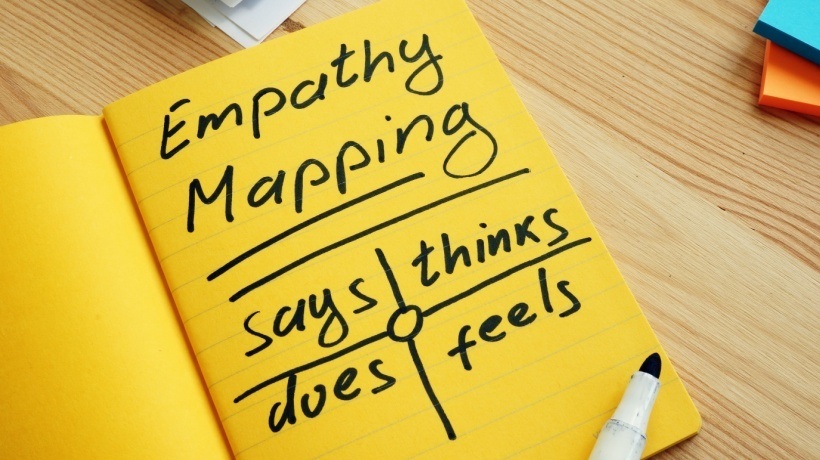What Are The Benefits Of Empathy Maps On Learner Experience?
When it comes to human interaction, empathy is a fundamental interpersonal skill. It allows us to understand other people's perspectives, needs, and emotions so that we can modify our communication techniques accordingly. Unsurprisingly, empathy is a valuable tool when it comes to designing learner experiences, too. Specifically, eLearning professionals have started utilizing empathy maps, a tool that was originally developed for design thinking, to better understand learner needs and preferences. In this article, we will look into the structure of empathy maps as well as 6 of the benefits they carry for learner experience.
What Is An Empathy Map?
Empathy maps are visual representations of the thoughts, feelings, actions, aspirations, etc., of a user or, in our case, a learner. To better capture and organize the information professionals insert in this graph, it is typically divided into the following four quadrants.
Says: Which specific words and phrases do learners use to describe their needs, goals, and hurdles?
Thinks: What are the major thoughts, beliefs, and preoccupations that learners don't express out loud?
Feels: What are the feelings and emotions learners experience throughout the learning journey? Which phases excite, motivate, or frustrate them?
Does: What actions and behaviors do learners exhibit as a result of the learning environment you have created for them? These observable behaviors include interactions not only with the learning material but also with their peers.
The information needed for these quadrants is collected through research, interviews, surveys, and observations. The more thorough you are in this stage, the deeper levels of empathy you will achieve and the higher the possibility of enjoying the benefits of empathy mapping.
6 Ways Empathy Maps Benefit Learner Experience
1. Understanding Learner Needs
The most important benefit of empathy maps and their fundamental function is that they help eLearning professionals gain a deeper understanding of their audience's needs. These tools go deeper than a surface analysis of learner feedback. They focus on underlying motivations, goals, and challenges, thus uncovering solutions to unspoken issues. Additionally, empathy mapping can identify the various personas that make up your target audience as well as their specific needs and preferences. This way, they help you develop learning experiences that are engaging, relevant, and tailored to each learner group.
2. Personalizing Learning Experiences
One-size-fits-all approaches can only be so successful in capturing and maintaining the attention of online learners. On the contrary, empathy maps empower eLearning professionals to identify specific activities, learning material formats, content, and assessments that perfectly fit the strengths and weaknesses of their audience. With the comprehensive information gathered during the empathy mapping process, you can uncover fitting instructional strategies and intrinsic motivators that will not only enhance engagement but also material comprehension and long-term knowledge retention.
3. Identifying Challenges And Pain Points
Often, learners face various challenges throughout the learning process, many of which they can't effectively express. Empathy maps will help you uncover obvious as well as obscure pain points, highlighting areas where learners are struggling. Additionally, you will be able to identify expectations that are not being met. Armed with this knowledge, you will be in a position to offer learners personalized support for the unique issues they are facing with your eLearning course. You will also be able to pinpoint opportunities for improvement and innovation, thus enhancing the overall quality and effectiveness of the learning experience.
4. Enhancing Communication
Another benefit is the boost in effective communication between instructors or developers and their learners. Often, the two groups are isolated, learning or developing content in a vacuum. This can harm the efficiency of the eLearning program and cause challenges and issues to arise. With empathy maps, you can step into your audience's shoes and discover exactly how they're experiencing learning. This developed sense of empathy streamlines communication channels, helping instructors not only address existing issues but also anticipate future ones and take proactive steps to prevent them.
5. Fostering Emotional Intelligence
Emotional intelligence is an important skill for learners and educators alike. On the one hand, educators learn how to view things from their audience's perspective, empathize with their unique experiences, and modify learning according to their thoughts and emotions. On the other hand, learners can better understand their own feelings, self-regulate, and relate with their peers. A developed sense of empathy and emotional intelligence as a whole fosters a more supportive and compassionate learning environment that brings better learning outcomes.
6. Driving Continuous Improvement
The final benefit of empathy maps you need to take advantage of is their dynamic nature. By allowing you to continuously monitor your learners, empathy maps evolve at the same speed with their ever-changing needs. New information replaces the old, allowing you to have a complete and updated understanding of their unique characteristics at any given moment. Additionally, by comparing your insights over time, you can gauge the progress of learner satisfaction rates. This iterative process fosters a culture of continuous improvement that ensures an ever-improving learner experience and, in turn, learning outcomes.
Conclusion
Empathy maps are powerful tools that can help eLearning professionals unlock the mystery behind what their audience is thinking and feeling in the context of their eLearning journey. The information they offer access to contributes to creating personalized, user-centric learning experiences that boost learner engagement and optimize learning outcomes. Use the information we shared in this article to unlock the potential of empathy mapping and pave the way for more effective and impactful learning.

